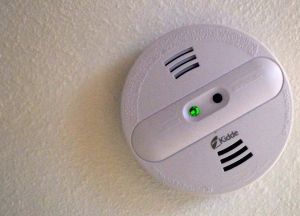[ad_1]
Contributed by Debbie Clason, staff writer, Healthy Hearing
A new code provision from the National Fire Protection Association (NFPA), makes it easier for those with high-frequency hearing loss to hear smoke alarm and CO detector alerts. The NFPA revised their code after a 2006 study by researchers at Victoria University in Australia indicated individuals with hearing loss were more likely to be awakened with lower-frequency tones. Notification appliances must now emit a lower frequency signal of 520 Hz in a square wave tone, compared to the more commonly used 3100 Hz higher-frequency tone. Regulations for smoke alarms in sleeping quarters went into effect January 1, 2014; those for CO detectors went into effect January 1, 2015.
Uniquely, the new code will also benefit other individuals who may not have hearing loss. While the Victoria University study revealed that lower-frequency tones awakened 92 percent of study participants with hearing loss, it was also 63-69 percent more effective at waking sleeping children and heavy sleepers, including those who were under the influence of alcohol or sleep medication.
Smoke alarms for individuals with hearing loss

much easier for individuals with hearing loss!
October is Fire Safety month and if you have a hearing loss, it’s a good time to make sure you have the appropriate type of smoke alarm to keep you and your family safe. Home fires are the fourth highest cause of accidental death in the United States and most occur at night when occupants are asleep.
“Extensive studies have shown that almost all adults with normal hearing wake up within 32 seconds of the start of a standard 3100 Hz alarm at 60 decibels,” Susanne Jones, HIS and customer support specialist for Healthy Hearing, said, “compared to only half of adults who are hard of hearing. This puts them at unacceptable risk of injury or death due to a house fire.”
Fortunately, there is a variety of products available to consumers with hearing loss which can mitigate the risk. In addition to new smoke alarms which emit a louder, lower-pitched tone, there are also alarms which use visual signals, such as a strobe light, and vibrotactile signals which shake the bed or pillow.
Some alarms are designed to work with the home’s existing fire detection system and are reasonable priced at approximately $150. These devices, which look a lot like a common alarm clock, sit on the nightstand and listen for the sound of the home’s existing alarm system. When an alarm is detected, the device emits a loud, low-pitched sound accompanied by flashing lights and vibration from an optional bed shaker. Because they are portable, they can travel with you on vacation or visits to the homes of family and friends.
“If you have a loved one with hearing loss, an alerting device like these can be the perfect holiday gift that says you care about their safety,” Jones said. “If you have hearing loss, please talk to your hearing hearing care practitioner today about how alerting devices can help you wake up if there’s a fire at your home.”
CO detectors for individuals with hearing loss
Carbon monoxide, or CO, is a colorless, odorless gas produced from fossil-burning fuels used in furnaces, boilers, water heaters and fireplaces. Depending upon where you live, state or city laws may require you to have a working CO detector installed in your home. Even if they don’t, it’s a good idea to have one. Experts recommend installing a CO detector at least 15 feet from the entrance of each bedroom as well as one on every level of your home.
Much like smoke alarms for individuals with hearing loss, carbon monoxide detectors are available with strobe lights and vibrating devices. The new NFPA codes also apply to these devices, which means these appliances must now emit a loud, low-frequency signal.
What is high-frequency hearing loss?
The National Institute on Deafness and Other Communication Disorders (NIDCD) estimates 26 million Americans between the ages of 20 to 69 have high frequency hearing loss as a result of exposure to noise at work or during leisure activities. Aging, genetics, certain medications and disease can also cause high-frequency hearing loss. Individuals with this type of hearing loss may have difficulty hearing sounds like the letters s, h and f and frequencies higher than 2,000 Hz.
Hearing aids and cochlear implants can help manage and treat most cases of high-frequency hearing loss. Hearing health experts recommend using earplugs and other hearing protection in environments with noise louder than 80 decibels to prevent this hearing loss.
Keep your family safe
To survive a house fire, fire safety experts say you must exit the house within three minutes. If you are hard of hearing, it’s important for you to install equipment that can help you and your family make a safe and hasty escape.
“Many hearing aid wearers can hear just fine during that day while they’re wide awake and wearing their hearing aids,” Jones said. “Unfortunately, fire emergencies can occur at any time of day or night and people with hearing loss can be at markedly increased risk in those situations. As a hearing care professional, I’m pretty adamant about people with significant hearing loss having appropriate smoke / fire alerting devices designed for their hearing loss. I think that’s the most important thing people with hearing loss can do for fire safety.”
[ad_2]
Source link

